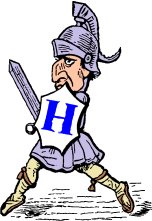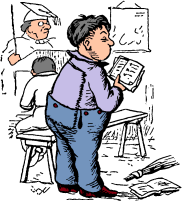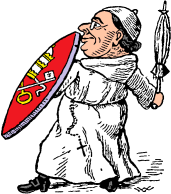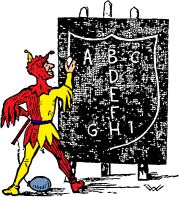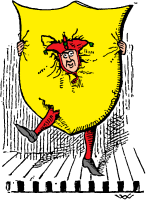HOME
Preface
Introduction
1
2
3
4
5
6
7
8
9
10
11
12
13
14
15
16
17
18
19
20
21
22
23
IV
CHAPTER IV.
OF THE SHIELD, OR ESCUTCHEON,
AVING detailed the different varieties of Arms, and how each may be acquired, we next come to consider the Shield, or Escutcheon. With it, however, we do not intend to cover our own deficiencies, but shall boldly proceed on our poaching expedition on the peculiar field of the Heralds' College, though in our own manner. The science may be strictly preserved by Garter, Ulster and Co.; still in these free-trade times, we hope to find some game in it.
Shields are of many kinds, both in and out of Heraldry. First, there is the shield proper, used by ancient warriors, and on which their Arms were blazoned, and which, while tasting the gaudia certaminis, or honey of fighting, they avoided getting too much of the whacks. Then there are the shields improper, such as the copy books which peccant schoolboys place under their jackets and unmentionables, prior to being taught that extremely practical, if free translation, of the first line of the Æneid, viz., "Arma virumque cano,"--arms and the man (or boy) I cane. On this improper shield, or rather on the skin beneath it, the blazon after the visitation is principally sable, gules, and azure. Again, when a wife sets down as "sundries" the sum spent out of the house money on a new dress, it may also be considered as a shield; also, perhaps, an improper one; and as we do not intend to have anything to do with what is improper, we will return to the first mentioned
kind, and will no longer stand shivering on the edge of the shield, but at once jump boldly into its middle.
In Heraldic language the shield is the ground upon which the Coat of Arms is blazoned or painted, and on which the achievements of the owner were not only symbolically depicted couleur de rose, but also in all the colours of the rainbow as well.
Originally, the devices were placed upon the buckler, but after a time finding that in battle, from the colours not being "warranted fast," they were very apt to get chipped off, or otherwise damaged, the knights had them painted on their banners instead; perhaps in the belief that a sight of the flag of their masters might have the effect of raising the flagging courage of their retainers, who in such moments became special retainers in their service.
Shields, like bonnets, were of various shapes; although, unlike modern bonnets, there was a good deal of them. In very ancient times they were shaped like a horse-shoe,--to typify, perhaps, the hammering they occasionally received,--or triangular. Sometimes, also, the shields were heptagonal, or with seven points. This shape must have been awkward to carry, as unless the bearer was very careful, the sharp points must have either run into his chin or penetrated his thigh, scarcely we should say an incentive to prowess on general principles.
Mark Antony, the triumvir, had one of this pattern; but as at the battle of Actium he very decidedly lost the game, to say nothing of such a trifle as his own life, the seven points of his shield were certainly not in his favour on that occasion.
Coming down, however, to more modern times, we find that the shields of Knights-bannerets were square, while those of priests were oval, but as these soldiers of the church militant, with some few exceptions, set far too high a value on their holy hides to risk them in so perilous an amusement as fighting, it did not much matter what shape were their shields.
Ladies, again, whose principal weapon of defence, and also offence, were and are their tongues, and who consequently had no real use for shields, nevertheless were provided by the Heralds with those articles in a lozenge shape, recalling to uninitiated minds the jujube of domestic life with great reality.
It now remains to us to describe the Heraldic Shield, or Escutcheon, as received at the present day; and, here, we must apologize to our readers if, in order to make our subject intelligible, which is more than are all subjects of our gracious sovereign, especially after dining out, we sometimes light on ground so dry, that not even the most inveterate jester could moisten it with a single joke; but we will promise to go as swiftly over these arid plains as we possibly can; and, who knows, we may find a well of entertainment, out of which, however, we promise to throw no cold water over our disciples.
Ladies and gentlemen! this is the Heraldic Shield. Observe the letters, which are literally the A B C of the science. Every one has its meaning, which is more than can be said of the letters of some people. A B C are the first we will meddle with, and these three are called "The Chief," but have no connexion either with Indian or Scottish chiefs. A is the dexter, or right chief; B is the precise middle chief, and C the sinister, or left chief. The last reminds one of an unpleasant Ojibbeway, with a taste for getting up in the middle of the night and scalping his sleeping friends. Every school-boy will tell us that D follows C in the alphabet, and so it does also in the shield. It is called the "Honour Point." Next comes E, and this is the "Fess Point;" observe, also, it is the exact centre of the shield, and therefore, even when nicely pointed, can only be pretty middling. Then we have F, which is called the "Nombril," or "Navel Point;" and, last of all, there is G H and I, the
dexter, middle, and sinister base points.
This concludes our description of the partition of the shield ; and we really don't see how we can say any more about it. However, having thus divided it, we shall now consider the style of articles to be placed upon it; their manners, customs, habitations, general style of appearance, failings, good qualities, and all the other distinct and wonderful peculiarities which characterise the Heraldic Escutcheon.
These are--but no--for further particulars, see next chapter.
IV
1
2
3
4
5
6
7
8
9
10
11
12
13
14
15
16
17
18
19
20
21
22
23
Preface
Introduction
HOME
Build: 2019/04/20 14:20:08.59+0900(JST)


